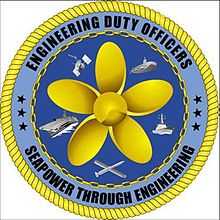Engineering Duty Officer

An engineering duty officer is a restricted line officer in the United States Navy, involved with the design, acquisition, construction, repair, maintenance, conversion, overhaul, or disposal of ships, submarines, aircraft carriers, and the systems on those platforms (weapons, command and control, communications, computers, etc.). As of November 30, 2011, there are approximately 791 engineering duty officers on active duty in the United States Navy, representing approximately 1.5 percent of its active-duty commissioned officers. [1]
Mission
The Engineering Duty Officer Community Leadership has stated that the purpose of the engineering duty officer community is "to provide experienced Naval Engineers known for bringing effective technical and business solutions in support of Naval Power 21 ; respected for integrity, adaptability, and agility. Engineering duty officers ensure that our naval and joint forces operate and fight with the most capable platforms possible. We are involved with the design, acquisition, construction, repair, maintenance, conversion, overhaul, and disposal of ships, submarines, aircraft carriers and the systems on those platforms (weapons, command and control, communications, computers, etc.). Engineering duty officers are unique to the Navy because we all start our career as URL officers. First, we learn how to operate ships or submarines. Next, all EDs obtain technical/engineering Master's degrees. Then, we combine that operational experience and technical knowledge to become the technical business leaders for the Navy."
Insignia
As line officers of the Navy, engineering duty officers wear an inverted gold star above their rank stripes on both their dress blue uniforms and on their shoulder boards. In virtually all respects, their uniforms are indistinguishable from their URL counterparts. The two predominant sources of new engineering duty officers are by Lateral Transfer from another designator or by choosing to exercise an Engineering Duty Option granted upon commissioning. A requirement for Lateral Transfer, or for exercising an Engineering Duty Option, is the completion of either Submarine Warfare or surface warfare qualification. Therefore, the vast majority of Engineering Duty Officers wear either the same Submarine Warfare or Surface Warfare insignia as their URL counterparts.
A small number of engineering duty officers not previously qualified as submarine warfare officers volunteer for the Engineering Duty Dolphin Program, and by successfully completing it, earn their Submarine Engineering Duty insignia. The submarine engineering duty insignia is the only United States Navy insignia which is unique to Engineering Duty Officers.
Areas of specialization
Current engineering duty officers serve in one of several career fields, including:
- Program management of surface ship, submarine, weapons, ballistic missile, missile defense, or C5I systems acquisition programs.
- Maintenance of surface ships and submarines at naval shipyards and smaller-scale maintenance facilities.
- Naval systems engineering.
- Underwater ship husbandry, diving, and salvage.
- The Naval Nuclear Propulsion Program.
History
The importance of engineering duty officers in United States Navy history is memorialized in a bronze bas-relief by American sculptor Antonio Tobias "Toby" Mendez , on the sculpture wall at the United States Navy Memorial in Washington DC, entitled "Engineering Duty Officers – 'Sharpening the Point of the Spear.' " This is one of 26 such reliefs along southern hemisphere of the Granite Sea at the Navy Memorial, which commemorate events, personnel, and communities of the various sea services.
Notable engineering duty officers
- Admiral Hyman G. Rickover, USN, "Father of the Nuclear Navy."
- Admiral Samuel M. Robinson, USN, Director of Material and Procurement during World War II and first Chief of the Bureau of Ships.
- Vice Admiral George P. Nanos, USN, former Commander of the Naval Sea Systems Command and Director of Los Alamos National Laboratory.
- Vice Admiral Kevin M. McCoy, current Senior Engineering Duty Officer, and forty-second Commander of the Naval Sea Systems Command.
- Commodore George R. Salisbury, USN, 15th Naval Governor of Guam.
- Rear Admiral Wayne E. Meyer, USN, "father of Aegis".
- Rear Admiral William S. "Deak" Parsons, USN, Assistant Chief of the Bureau of Ordnance, known for assembling (in flight) the triggering mechanism of the atomic bomb "Little Boy" aboard the Enola Gay.
- Rear Admiral Benjamin F. Isherwood, USN, Civil War–era engineer-in-chief of the Navy and founder of the Bureau of Steam Engineering.
- Rear Admiral George W. Melville, USN, pioneering advocate of warship steam propulsion and engineer-in-chief of the Navy.
- Rear Admiral David W. Taylor, USN, chief constructor of the Navy during World War I, and builder of the United States' first experimental warship towing tank.
- Rear Admiral Henry A. Schade, USN, designer of the Midway-class aircraft carrier, and later a director of the Naval Research Laboratory.
- Rear Admiral Kathleen K. Paige, USN, first Ballistic Missile Defense System technical director at the United States Missile Defense Agency.
- Captain Willard F. "Bill" Searle Jr., USN, former Navy Supervisor of Salvage, and coordinator of the USS Scorpion (SSN-589) search effort and of the search for a lost nuclear warhead (B28 nuclear bomb) near Palomares, Spain in 1966.
- Captain Heidemarie M. Stefanyshyn-Piper, USN, Space Shuttle astronaut mission specialist and Navy diver.
References
- ↑ RADM Clarke Orzalli, Engineering Duty Officer Community Update.